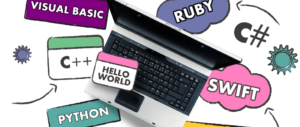If you’re diving into the world of machine learning, the first hurdle is deciding where to start. With over 700 programming languages out there, each with its own strengths and weaknesses, the task may seem daunting.
However, as you embark on your journey as a machine learning engineer, you’ll discover the best language for specific tasks. But first, let’s understand what machine learning is and the programming required to implement it.
Machine learning, a subset of artificial intelligence, empowers computer systems to learn and make predictions based on data. This could range from deciphering the meaning of a word to identifying objects in an image or determining if an email is spam.
Unlike traditional programming, where a coder writes explicit instructions, machine learning relies on large datasets to train models, enabling them to learn and make decisions autonomously.
The level of programming expertise needed for machine learning varies depending on your goals. If you aim to tackle real-world business problems using machine learning models, a programming background is essential.
However, for those looking to grasp the basics, a foundation in math and statistics may suffice. Proficiency in programming fundamentals, algorithms, data structures, memory management, and logic is necessary to implement machine learning models. While there are user-friendly environments like Weka, Orange, and BigML that minimize coding efforts, a solid understanding of programming is crucial.

Contrary to the idea of a superior machine learning language, different languages have their strengths. Python is a favorite among machine-learning engineers for natural language processing (NLP), while R and Python find use in sentiment analysis tasks. Java, with its background in security and threat detection, is preferred by some engineers.
It’s essential to note that there’s no one-size-fits-all solution, and the best language depends on the specific use case, project scope, industry standards, and personal preference.
In the dynamic field of machine learning, trends evolve, and preferences shift. What works best today may not be as effective tomorrow. Thus, it’s crucial to stay adaptable and open to learning new languages.
A machine-learning practitioner relies on experience, testing, and experimentation to choose the most suitable language for a given problem. Flexibility is key, and learning multiple machine-learning languages enhances your skill set and makes your resume stand out.
Several factors influence the choice of a programming language for machine learning. These include the specific application area, the project’s scope, prevalent languages in your industry or company, and other contextual aspects.
A practitioner leverages their experience to make informed decisions, recognizing that there’s no one definitive answer. Ultimately, the best language is the one that aligns with the unique requirements of the machine-learning problem at hand.
While there’s no mandate to master a single best language, learning at least two machine-learning programming languages is advisable. Doing so not only enhances your versatility but also makes you a more valuable asset in the field.
Once you’ve mastered one language, picking up another becomes a more straightforward task. Embracing this approach not only broadens your skill set but also positions you as a well-rounded machine-learning professional.
Choosing the right programming language for machine learning may seem like a complex decision, but it’s a journey of exploration and adaptation. As you delve into the intricacies of machine learning, keep in mind that the landscape is ever-evolving.
Embrace the diversity of languages, stay curious, and be prepared to learn and adapt. In the dynamic realm of machine learning, your ability to navigate through various languages will be your key to success.


Privacy Policy: We hate spam and
promise to keep your email address safe


Privacy Policy: We hate spam and
promise to keep your email address safe


Privacy Policy: We hate spam and
promise to keep your email address safe


Privacy Policy: We hate spam and
promise to keep your email address safe


Privacy Policy: We hate spam and
promise to keep your email address safe


Privacy Policy: We hate spam and
promise to keep your email address safe


Privacy Policy: We hate spam and
promise to keep your email address safe


Privacy Policy: We hate spam and
promise to keep your email address safe


Privacy Policy: We hate spam and
promise to keep your email address safe


Privacy Policy: We hate spam and
promise to keep your email address safe


Privacy Policy: We hate spam and
promise to keep your email address safe